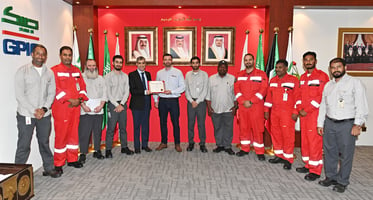By using your own gas testing equipment during an authorised gas tester training session at your...
What is the maximum number of people allowed on a gas testing course?
In order to ensure the highest quality of education and training, accreditation bodies have decided upon an acceptable limit on the ratio of learners to trainers for gas testing courses.
This ratio of 12 learners to 1 trainer has been carefully determined to provide the most effective and personalised learning experience for each participant.
By adhering to this guideline, students can benefit from individualised attention, hands-on practical training, and comprehensive theoretical instruction. This optimal ratio not only enhances the overall learning outcomes but also ensures the safety and competency of future gas testers in the industry.
How Many People Can Attend an Authorised Gas Tester Training Course?
If you work in an industry that involves gas testing, such as oil and gas, petrochemical, pharmaceutical, or shipping, you may need to undergo an Authorised Gas Tester Training Course. This course will teach you the skills and knowledge required to perform gas testing safely and effectively, in accordance with international standards and best practices.
But how many people can attend an Authorised Gas Tester Training Course at the same time? Is there a limit to the number of participants that can be trained and certified in one session? What are the factors that affect the optimal class size for this type of training?
In this blog post, we will answer these questions and provide some guidelines on how to choose the right number of people for your Authorised Gas Tester Training Course.

What is an Authorised Gas Tester Training Course?
An Authorised Gas Tester Training Course is a programme that covers the theory and practice of gas testing in various work environments and scenarios. The course aims to equip the participants with the following knowledge:
- Understand the legislative controls, properties, characteristics, and behaviours of flammable and toxic gases
- Recognise the asphyxiating and narcotic effects of different gases on human health
- Operate and maintain different types of gas sensors, such as personal, transportable, and portable
- Conduct gas testing for confined spaces, hot work, and other situations that require gas monitoring
- Interpret and report the gas test results and take appropriate actions
- Follow the relevant procedures, guidelines, and safety precautions for gas testing
The course consists of a combination of classroom lectures, demonstrations, practical exercises, and assessments. The course duration may vary depending on the provider, but it is typically two days long. The course is suitable for anyone who needs to perform gas testing as part of their job role, such as:
- Authorised Gas Testers, who are responsible for conducting gas testing and issuing gas test certificates
- Gas Monitors, who are responsible for providing safety watch duties and monitoring the gas levels at the work site
- Confined Space Entrants, who are responsible for entering and working in confined spaces that may contain hazardous gases
- Hot Work Performers, who are responsible for carrying out hot work activities that may generate flammable or toxic gases
- Supervisors, Managers, and Safety Officers, who are responsible for overseeing and ensuring the safe conduct of gas testing and related work activities
What is the Optimal Number of People Allowed on an AGT Course?
There is no definitive answer to this question, as different providers may have different policies and standards for their Authorised Gas Tester Training Courses. However, based on our research and experience, we have found that the maximum number of people allowed on an Authorised Gas Tester Training Course is usually between 8 and 12.
This number is based on several factors, such as:
- The availability of equipment and facilities. The course requires participants to have access to gas detectors and associated ancillary equipment. The course also requires a suitable venue that can accommodate the classroom sessions and the practical exercises. The venue should have enough space, ventilation, lighting, and power supply for the training activities. The provider should ensure that there is enough equipment and facilities for the number of participants they accept.
- The quality of instruction and interaction. The course involves a lot of technical information, practical skills, and safety procedures that need to be taught and learned effectively. The instructor should be able to deliver the course content clearly and comprehensively, and answer any questions or doubts that the participants may have. The instructor should also be able to observe and assess the performance of each participant during the practical exercises, and provide feedback and guidance as needed. The participants should also be able to interact and collaborate with each other, and share their experiences and insights. The provider should ensure that the number of participants does not compromise the quality of instruction and interaction.
- The health and safety of the participants. The course involves working around confined spaces, hot work sites, and other potentially dangerous areas on site. The provider should ensure that the number of participants does not pose any health and safety risks to themselves or others. The provider should also ensure that the participants follow the appropriate precautions and measures to prevent any accidents or incidents during the course.
How to Choose the Right Number of People for Your AGT Training Course?
If you are planning to organise or attend an Authorised Gas Tester Training Course, you may wonder how to choose the right number of people for your course. Here are some tips and considerations to help you make the best decision:
- Consider your objectives and expectations. What are the main reasons and goals for taking or providing the course? What are the specific outcomes and benefits that you want to achieve or deliver? How do you measure the success and effectiveness of the course? These questions will help you determine the optimal number of people that can meet your objectives and expectations.
- Consider your budget and resources. How much money and time can you afford to spend or allocate for the course? How many equipment and facilities do you have or need for the course? How many instructors and staff do you have or need for the course? These questions will help you determine the feasible number of people that can fit your budget and resources.
- Consider your target audience and their needs. Who are the intended participants and recipients of the course? What are their backgrounds, roles, and responsibilities? What are their current levels of knowledge and skills? What are their learning styles and preferences? These questions will help you determine the suitable number of people that can cater to your target audience and their needs.
An Authorised Gas Tester Training Course is a valuable and essential programme for anyone who works with gas testing. The course will teach you the theory and practice of gas testing, and prepare you to perform gas testing safely and effectively.
The maximum number of people allowed on an Authorised Gas Tester Training Course is usually between 8 and 12, depending on the provider and the factors that affect the class size. To choose the right number of people for your course, you should consider your objectives, budget, resources, target audience, and their needs.
If you are looking for a reliable and reputable provider of Authorised Gas Tester Training Courses, we recommend you to check out JMS Consultants, Petrofac, Survivex, or Dräger. These providers offer high-quality, affordable, and customisable Authorised Gas Tester Training Courses that can suit your needs and expectations.









